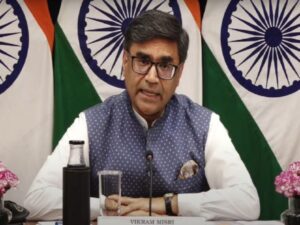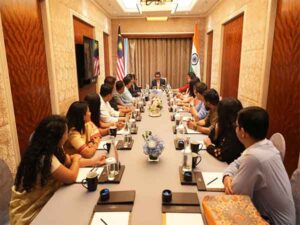Year-ender 2022: How a ‘custodial death’ took women to war against Iran’s now-abolished ‘morality’ police
Tehran [Iran], December 31 (ANI): An unsparing regime known to crush dissent with an iron fist pulled out all its administrative levers to tamp down on protests by a band of women standing up for their rights and dignity. However, all it did was fan the fire.
The alleged custodial death of 22-year-old Iranian woman Mahsa Amini, who had come visiting her brother in Tehran on September 13, 2022, fell in the crosshairs of the country’s so-called morality police instead. She was arrested, allegedly for wearing her hijab (headscarf) loosely, at the point of entry of the Shahid Haghani Expressway of Tehrah and hauled away by the Guidance Patrol, known locally as the Gasht-e Ershad. She was turned over to the custody of the country’s Moral Security where she died three days later, allegedly after slipping into a coma.
The death sparked fury and civilian protests seldom seen on the streets of Tehran, with citizens, across age and gender, clogging the corners and chanting death to the ‘morality police’ who they blamed for killing the 22-year-old in custody.
While the regime claimed Amini died of a heart failure, her family members alleged a cover-up saying she had been murdered.
According to Al Jazeera, however, Amini, post her detention by the specialist police unit, suffered a heart attack and was immediately taken to hospital with the cooperation of the country’s emergency services.
The flames of civilian fury that were lit on September 17, after Amini’s funeral at her native Kurdistan province in Iran’s northwest, spread to 80 cities, including Tehran, in no time.
As the protests swelled, the regime, quite literally, rolled out the cavalry, with police in full riot gear unleashing a brutal crackdown on the dissenters.
Viral videos of the country’s riot police cracking down on peaceful assemblies against the regime drew global censure.
According to reports, the civilian unrest that followed Amini’s death saw multiple arrests and, at least, 17 deaths.
However, the protest fire had, by then, become a global movement, with Iran’s strict enforcement of dress codes for women, especially the hijab rule, being called into question.
And, in what became a feature of the street protests that followed Amini’s death, women set their hijabs on fire and chopped their hair in a show of solidarity with one of their own who refused to stand down and yield to the dictates of the ‘morality’ police.
While their unforgiving manner of enforcing dress codes has been frowned upon, Iran’s ‘morality’ police, which according to media reports, dedicated themselves to setting headscarves right and shoving the morality pill down defiant throats, attained global notoriety of the kind that it, perhaps, never had, in Amini’s wake.
As the protests raged in the country and beyond, the Amnesty International, a global human rights watchdog, came out with a statement saying, “The circumstances leading to the suspicious death in custody of 22-year-old young woman Mahsa Amini, which include allegations of torture and other ill-treatment in custody, must be criminally investigated.”
Viral videos of women protesters shouting anti-government slogans at a gathering in Saqqez, the hometown of Amini, touched off a fire that soon engulfed the country.
Masih Alinejad, an Iranian journalist and activist, in September shared a video on her social media account of women snipping off their hair in solidarity in Amini. She tagged the video with a message that read, “Iranian women show their anger by cutting their hair and burning their hijab to protest against the killing of #Mahsa_Amini by hijab police.”
The alleged custodial death of the 22-year-old woman over a dress code violation also drew the red eye of other world bodies such as the United Nations (UN) and the European Union (EU).
The UN, according to an Al Jazeera report, demanded an independent investigation into Amini’s death.
UN experts strongly condemned the death of the 22-year-old in police custody after her arrest for allegedly wearing an ‘improper hijab’.
In a press statement, the UN Human Rights Office said the experts also denounced the violence directed at peaceful protesters and human rights defenders, demanding accountability for Amini’s death in cities across the country by Iranian security forces.
They urged the Iranian authorities to avoid further unnecessary violence and immediately stop the use of lethal force in policing peaceful assemblies.
“We are shocked and deeply saddened by the death of Amini.
She is another victim of Iran’s sustained repression and systematic discrimination against women and the imposition of discriminatory dress codes that deprive women of bodily autonomy and the freedoms of opinion, expression and belief,” an expert said.
In October, a month after the death of Amini, a European lawmaker cut off her hair during a debate in Parliament to express solidarity with the protesting Iranian women.
Addressing a EU debate in Strasbourg, Swedish politician Abir Al Sahlani said, “We, the people and the citizens of the EU, demand an unconditional and immediate stop of all the violence against men and women in Iran.”
Around the same time, in a statement issued by the White House, US President Joe Biden said his country will continue to hold Iranian officials accountable and support the rights of people to protest freely.
“The United States will be imposing further costs on perpetrators of violence against peaceful protestors. We will continue holding Iranian officials accountable and supporting the rights of Iranians to protest freely,” Biden said in a statement.
Amid the protests, prolonged internet disruptions were also reported in Tehran, Kurdistan province and other parts of the country, starting September 19. It was noted as the third widespread internet shutdown recorded in Iran over the past 12 months, according to the UN Human Rights Office.
In another instance of Iran’s hardline dress code policies, the country’s President, Ebrahim Raisi, abruptly cancelled a scheduled interview with Chief international anchor Christiane Amanpour as she refused to wear a hijab live on air.
The interview was scheduled at a time when massive civilian protests had erupted on the streets of Iran in the wake of the alleged custodial death over a dress code violation.
Taking to Twitter, Amanpour said she was told to wear the headscarf and, upon her denial, the interview was cancelled.
In a series of tweets, the anchor said she planned to discuss the demonstrations in Iran, including numerous incidents of women burning their hijabs to protest Amini’s death, among other issues.
“This was going to be President Raisi’s first ever interview on US soil, during his visit to NY for UNGA. After weeks of planning and eight hours of setting up translation equipment, lights and cameras, we were ready. But no sign of President Raisi,” Amanpour said in a tweet.
According to reports, she waited 40 minutes for the Iranian President to show up for the interview, till it was eventually cancelled.
Amid the civilian unrest over Amini’s death, several other instances brought to light the state of the Iranian woman under the glare of the ‘morality’ police.
One such instance was of Iranian climber Elnaz Rekabi, who competed at an event in South Korea in October without wearing the wardrobe accessory mandated by her country’s hardline Islamist government. She later had to tender an apology to the regime, saying it was purely by accident that she competed without wearing the hijab.
A text-only Instagram story posted on Rekabi’s account read, “Due to inappropriate timing, and an unpredictable call for me to climb the wall, there was accidentally a problem with my head cover.”
In another incident, Iranian chess player Sara Khadem took part in a tournament in Kazakhstan without wearing a hijab, the CNN reported.
And, in what was seen as a fallout of the massive outpouring of civilian fury and protest over Amini’s death, the so-called morality police of Iran was suspended in December, according to the country’s prosecutor general. The landmark decision was taken as the anti-hijab protest entered its third month.
Iran’s Attorney General Mohammad Javad Montazeri said the morality police “was abolished by the same authorities who installed it”, The New York Times reported.
In the first week of December, Iran executed a man for injuring a paramilitary officer, the CNN reported, citing the state media.
According to Iranian media, it was the first execution related to the anti-hijab protests that was made public.
The person, identified as Mohsen Shekari, was found guilty of using a machete to hurt a security official while blocking a street in Tehran.
The security officer was a member of the Basij paramilitary force — a wing of Iran’s Revolutionary Guard. It was alleged that he was injured by Shekari with a knife at a protest in Tehran on September 23.
Shekari was sentenced to death on October 23, the CNN reported citing Mizan Online, a news agency affiliated to Iran’s judiciary.
Further, according to reports, several Iranians received death-by-execution sentences during the nationwide demonstrations spurred by the alleged custodial killing of Amini.
Last year, in Iran, at least 333 people were executed, according to the Iran Human Rights. The report further revealed that 55 executions were announced by official sources.
As many as 83.5 per cent of all executions included in the 2021 report (278 executions in total) were not announced by the authorities, claimed the report, adding that at least 183 executions (55 per cent of all executions) were for murder charges.
Significantly, India abstained from voting on a United Nations Human Rights Council (UNHRC) resolution to set up a fact-finding mission to investigate the alleged human rights violations committed on protesters in Iran on September 16.
Taking to Twitter, United Nations Human Right Council said, “At its 35th special session, the @UN Human Rights Council decided to create a new fact-finding mission to investigate ‘alleged #HumanRightsViolations in the Islamic Republic of #Iran related to the protests that began on 16 September 2022’.”
The Iranian dress code, which applied to women of all religions, not just Muslims, required them to pull the veil over their heads, concealing the hair and neck, reported Al Jazeera.
Over the decades, women have increasingly pushed back against the ‘morality’ police, particularly in the big cities, by wearing their headscarves far back on their heads, revealing their hair.
If the custodial death of George Floyd in Minneapolis, Minnesota, which bared the country’s racial fault lines and spawned the global ‘Black Lives Matter’ movement, was a moment of reckoning for the United States; the alleged killing of Mahsa Amini in the clutches of Iran’s now-abolished ‘morality’ police was no less a seminal moment, which might have changed perceptions around the country’s women.






